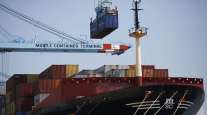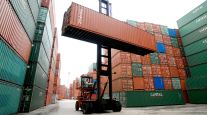International Cargo Drives Intermodal Freight Up 4.5% in 2Q

The trade association, which reports freight volume in the United States and Canada, counted 4.36 million shipments in the quarter, including 2.27 million international shipments, a 6.8% increase, and 2.09 million domestic loads, a rise of 2.2%.
“It is tempting to assume that the improvement in the second quarter is due to the release of pent-up demand accrued during the port disruptions in the first quarter,” the IANA report said, referring to West Coast cargo delays during labor negotiations. “Strengthening container import volumes also played a role in pushing international volumes higher.”
The trade group, based in Calverton, Maryland, linked the increased international cargo trend to the strong dollar that has encouraged imports at lower prices.
“Consumer-buying power due to the strong dollar will drive growth in imports even as exports continue to struggle due to the same strong dollar and economic weakness overseas,” the report said.
The report, which was released Aug. 5, provides the latest indicator of truck/rail freight growth during the period, when that freight outpaced all other rail freight combined. In addition, during June, U.S. railroads set a weekly intermodal volume record, according to the Association of American Railroads.
In contrast to the international trend, domestic truck/rail freight rose just 2.2%, one of the slowest increases since 2009.
IANA’s report said the 2.2% growth was similar to last year’s first quarter, when freight volumes were depressed by a particularly harsh winter.
“It’s not clear what’s behind the disappointing performance of domestic volumes in the second quarter,” the report said, offering multiple explanations. “It is possible that rail is losing share to trucking. It could be that transload [from international to domestic equipment] is losing share in some regions, or that the economy is not doing as well as hoped.”
The report did note wide variations in domestic container shipments by region, including a 9.6% increase in the Southeast, a 0.9% rise in the Northeast.
The report also noted the effect of changing trucking industry conditions on intermodal.
“Near-term headwinds will continue, particularly for the domestic side of the intermodal house,” the report said. “Truck capacity will remain generally available. Depressed diesel prices will reduce the economic impact of intermodal’s relative fuel efficiency.”
In addition, IANA detected a transition in U.S. economic growth trends away from industrial growth that should have an effect on freight volumes.
“Each [percentage] point of economic growth in the consumer side of the economy (i.e., heavy in services) generates less freight than equivalent growth in the industrial sector.”
With the shift toward more available truck capacity and lower overall freight volume, IANA’s report projected that second half 2015 truck/rail growth opportunities will have to result from successful conversion from all-highway to intermodal routing.
The report also suggested that full year-growth in intermodal could lag last year’s 2014 growth pace of 4.8%, which resulted in record volume of 16.3 million shipments.
“It will be difficult to make up for the heavily burdened first quarter,” IANA noted, when growth was barely above 3%.
In the first half of 2015, truck/rail shipments rose 3.9% to 8.26 million. During the first six months, loads were almost evenly split between domestic and international, with the latter group producing 50.5% of the shipment total.
Also included was an assessment of intermodal marketing company activity.
The report noted a 4.5% rise in intermodal loads managed by third parties and an 8.2% increase in all-highway shipments. Revenue totaled $1.64 billion, down 0.2% because of lower revenue from fuel surcharges.




